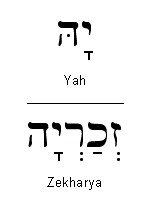The Hebrew alphabet, known variously by scholars as the Ktav Ashuri, Jewish script, square script and block script, is traditionally an abjad script used in the writing of the Hebrew language and other Jewish languages, most notably Yiddish, Ladino, Judeo-Arabic, and Judeo-Persian. In modern Hebrew, vowels are increasingly introduced. It is also used informally in Israel to write Levantine Arabic, especially among Druze. It is an offshoot of the Imperial Aramaic alphabet, which flourished during the Achaemenid Empire and which itself derives from the Phoenician alphabet.
Modern Hebrew has 25 to 27 consonants and 5 vowels, depending on the speaker and the analysis.

The mappiq is a diacritic used in the Hebrew alphabet. It is part of the Masoretes' system of niqqud, and was added to Hebrew orthography at the same time. It takes the form of a dot in the middle of a letter. An identical point with a different phonetic function is called a dagesh.

The dagesh is a diacritic that is used in the Hebrew alphabet. It takes the form of a dot placed inside a consonant. A dagesh can either indicate a "hard" plosive version of the consonant or that the consonant is geminated, although the latter is rarely used in Modern Hebrew.
In Hebrew orthography, niqqud or nikud is a system of diacritical signs used to represent vowels or distinguish between alternative pronunciations of letters of the Hebrew alphabet. Several such diacritical systems were developed in the Early Middle Ages. The most widespread system, and the only one still used to a significant degree today, was created by the Masoretes of Tiberias in the second half of the first millennium AD in the Land of Israel. Text written with niqqud is called ktiv menuqad.

The Tiberian vocalization, Tiberian pointing, or Tiberian niqqud is a system of diacritics (niqqud) devised by the Masoretes of Tiberias to add to the consonantal text of the Hebrew Bible to produce the Masoretic Text. The system soon became used to vocalize other Hebrew texts as well.

Aljamiado or Aljamía texts are manuscripts that use the Arabic script for transcribing European languages, especially Romance languages such as Old Spanish or Aragonese. This alphabet is also called the Morisco alphabet.
Waw is the sixth letter of the Semitic abjads, including Arabic wāwو, Aramaic waw 𐡅, Hebrew vavו, Phoenician wāw 𐤅, and Syriac waw ܘ.

The Hebrew language uses the Hebrew alphabet with optional vowel diacritics. The romanization of Hebrew is the use of the Latin alphabet to transliterate Hebrew words.
Aleph is the first letter of the Semitic abjads, including Arabic ʾalifا, Aramaic ʾālap 𐡀, Hebrew ʾālefא, North Arabian 𐪑, Phoenician ʾālep 𐤀, Syriac ʾālap̄ ܐ. It also appears as South Arabian 𐩱 and Ge'ez ʾälef አ.
The Hebrew diacritic U+05BCּHEBREW POINT DAGESH OR MAPIQ can represent:
ISO 259 is a series of international standards for the romanization of Hebrew characters into Latin characters, dating to 1984, with updated ISO 259-2 and ISO 259-3.

A Hebrew keyboard comes in two different keyboard layouts. Most Hebrew keyboards are bilingual, with Latin characters, usually in a US Qwerty layout. Trilingual keyboard options also exist, with the third script being Arabic or Russian, due to the sizable Arabic- and Russian-speaking populations in Israel.
Geresh is a sign in Hebrew writing. It has two meanings.
- An apostrophe-like sign placed after a letter:
- A note of cantillation in the reading of the Torah and other Biblical books, taking the form of a curved diagonal stroke placed above a letter.
Kamatz or qamatz is a Hebrew niqqud (vowel) sign represented by two perpendicular lines ⟨ ָ ⟩ underneath a letter. In modern Hebrew, it usually indicates the phoneme which is the "a" sound in the word spa and is transliterated as a. In these cases, its sound is identical to the sound of pataḥ in modern Hebrew. In a minority of cases it indicates the phoneme, equal to the sound of ḥolam. In traditional Ashkenazi Hebrew pronunciation, qamatz is pronounced as the phoneme, which becomes in some contexts in southern Ashkenazi dialects.

In Hebrew orthography the rafe or raphe is a diacritic, a subtle horizontal overbar placed above certain letters to indicate that they are to be pronounced as fricatives.
Kubutz or qubbutz and shuruk are two Hebrew niqqud vowel signs that represent the sound. In an alternative, Ashkenazi naming, the kubutz is called "shuruk" and shuruk is called "melopum".
Hebrew punctuation is similar to that of English and other Western languages, Modern Hebrew having imported additional punctuation marks from these languages in order to avoid the ambiguities sometimes occasioned by the relative lack of such symbols in Biblical Hebrew.
Begadkefat is the phenomenon of lenition affecting the non-emphatic stop consonants of Biblical Hebrew and Aramaic when they are preceded by a vowel and not geminated. The name is also given to similar cases of spirantization of post-vocalic plosives in other languages; for instance, in the Berber language of Djerba. Celtic languages have a similar system.

The Babylonian vocalization, also known as Babylonian supralinear punctuation, or Babylonian pointing or Babylonian niqqud Hebrew: נִקּוּד בָּבְלִי) is a system of diacritics (niqqud) and vowel symbols assigned above the text and devised by the Masoretes of Babylon to add to the consonantal text of the Hebrew Bible to indicate the proper pronunciation of words, reflecting the Hebrew of Babylon. The Babylonian notation is no longer in use in any Jewish community, having been supplanted by the sublinear Tiberian vocalization. However, the Babylonian pronunciation as reflected in that notation appears to be the ancestor of that used by Yemenite Jews.








